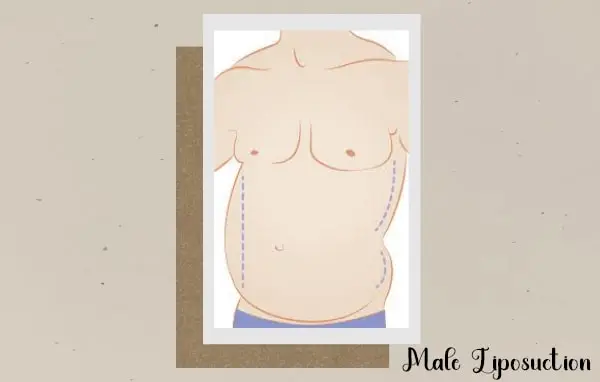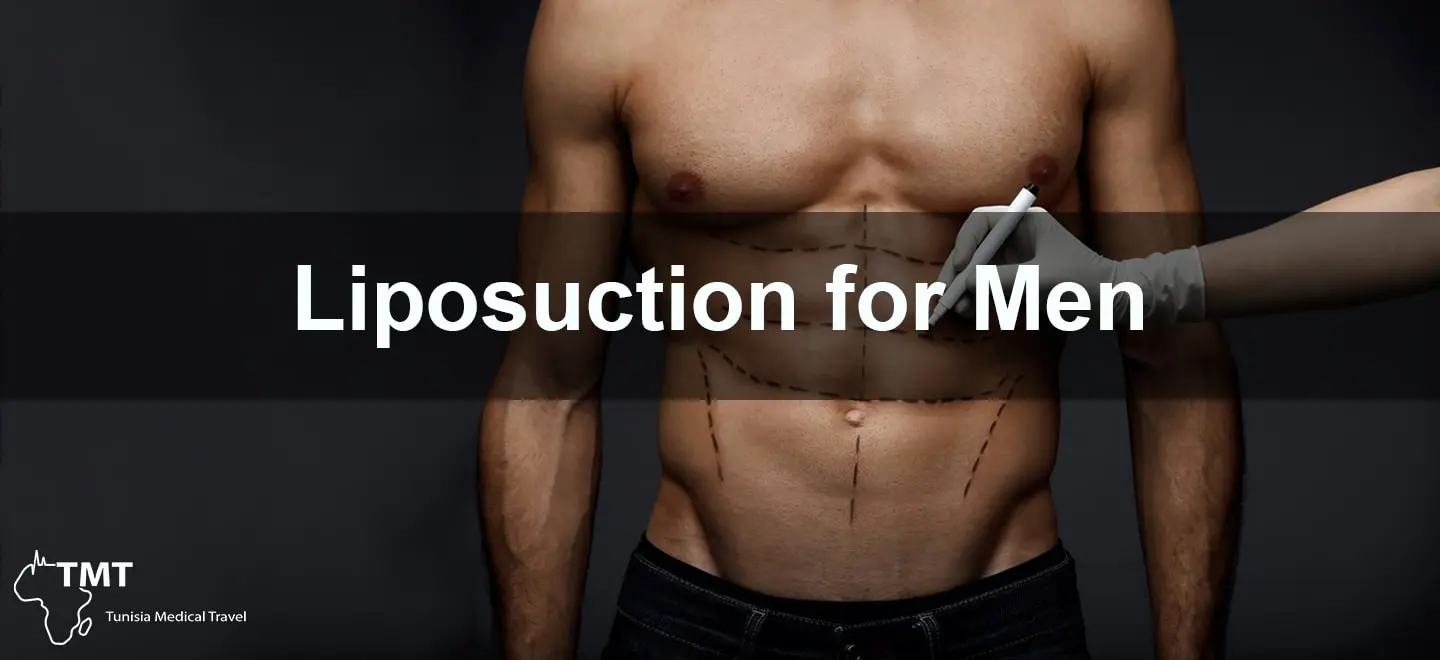Liposuction for Men
Liposuction for Men
What is male liposuction?
The discernible difference between male and female liposuction is the preferred method of the cosmetic surgeon. In women, it is common to use the tumescent method, which can be performed while the patient is awake and requires no general anesthesia. The recovery time is very quick, and patients can often return to work and their daily routine within a matter of days. Unfortunately, this procedure is not as feasible in men with very fibrous fatty tissue, and more pressure is applied with the cannula to break up the fat before it is removed. As a result, general anesthesia is often required for men, and recovery time is usually longer. How is it different from female liposuction? With the obvious exception of the patient’s gender, there isn’t much difference between the two procedures. Both procedures are very similar, and the main objective is the removal of fat cells, with the added bonus of shaping and contouring the body. However, the fatty deposits in men are typically firmer and more vascular than female fatty deposits. They are often found on the upper stomach and around the waist, i.e., « spare tire, » and above the breast. Sometimes, due to genetics, some men will also have fatty deposits on the lower back and around the neck. What is male liposuction? Liposuction, liposculpture, lipectomy, or « lipo » as it is often referred to, is a procedure used to remove unwanted fat from specific areas of the body. In this relatively straightforward procedure, the cosmetic surgeon uses a small stainless steel tube, the so-called cannula, to remove fat from a selected area of the body.
Benefits of fat removal surgery
Simple, the result is predictable after surgeries, and the time required to do activities during healing is predictable. Simply put, it does exactly what you expect it should, removing fat from selected areas to improve body contours. Reducing fat from a certain area could also be beneficial for people who have had previous injuries or illness that has left them with reduced muscle mass or unsymmetrical body features. By improving body contour, liposuction simply brings a physical benefit to a patient. Liposuction is one method for fat removal and it is not a magic cure for obesity. Although it is not a permanent fix for weight loss, it does provide long-lasting results. With a sensible diet and regular exercise, the results of liposuction are specifically tailored to the weight of a patient. If a patient were to gain moderate weight, for example 2-8 kilograms, then there would be a noticeable change in body contour but the areas that had been treated with liposuction would not generally accumulate fat as much as non-treated areas.

Procedure Overview: Male fat removal surgery
The liposuction procedure can best be described as a way to suction out fat from unwanted areas in the body. These areas usually consist of the abdomen, back, sides, and anything to do with the lower torso. To remove fat on the above body part, it is usually done with a tummy tuck or an abdominoplasty. In most cases, patients undergo liposuction and a subsequent tummy tuck to remove excess fat and sagging skin on stomach areas. For male liposuction, the typical age range is between 30-60 years old. There is no specific age where a patient is too old to receive liposuction, as long as the patient is in good general health. Liposuction is sometimes a last resort for patients who have tried dieting and exercising, or those who just cannot get themselves to lose the extra baggage. In fact, the more physically fit the patient, the easier the fat removal usually is, and the faster the recovery time for the patient.
Vaser
Vaser, or Vibration Amplification of Sound Energy at Resonance, is the latest technology shaping the future of liposuction. It is an advanced third generation internal ultrasound system using specifically designed probes to transmit sound energy and heat into the fatty tissue to emulsify, separate, and preserve the fat for use in body contouring. The major advantage of Vaser over traditional liposuction is the efficient and effective emulsification of fatty tissue while preserving surrounding tissues such as nerves, blood vessels, and connective tissue. The emulsified fat can then be removed using a suction process, much similar to the one used in traditional liposuction surgery, however with much smaller cannulas meaning a less invasive procedure and less trauma. The small incisions and effective fat removal, combined with the preservation of other tissues, lends Vaser to be a much more effective and safer method of body contouring over traditional methods of liposuction. This translates to less downtime, bruising, swelling, and pain and much quicker results that can often be seen immediately. Contour irregularities are also much less likely to occur with the added benefit of skin retraction.
Laser
Laser-assisted liposuction has become an important adjunct to liposuction with the introduction of the fiberoptic devices. The laser delivers a greater amount of energy to the fat cells, causing them to rupture, while simultaneously heating the dermis and causing skin tightening. The addition of the laser to liposuction led to the development of L.A.L. (laser-assisted liposuction). L.A.L. has been possible with the use of both internal and external laser devices. Internal devices are passed just below the skin and above the muscle fibers. The heat from these devices can be very effective at treating small areas of unwanted fat, frequently with skin tightening. External devices are passed over the skin. These devices are often more effective at treating a larger area of fat, though larger areas treated in the subcutaneous fashion may be associated with more irregularity postoperatively. An advantage of the external devices is that a patient may be more aggressively warmed. MRI studies have proved that lymphatic and portal venous vasculature may be dilated, increasing the drainage of tissue edema into the portal venous system, thus decreasing the duration up to which patients experience edema. An obvious disadvantage of the laser is the potential for a thermal injury to the skin; this has been a significant issue with early prototype devices, though some of the modern devices are much safer. High-powered devices are frequently associated with significant pain in the postoperative period. Recommendations for the laser are typically based upon the amount of adiposity, skin type, and potential for skin laxity. There are many non-invasive options for skin tightening or cellulite that can be very effectively treated with the low setting on devices meant for fat removal.
Traditional
Despite the fact that old techniques for large volume fat removal have their problems, they can still be the best method in some areas. If the patient has an abundance of fat to remove and cannot afford the latest procedures, it is also still extremely possible to achieve good results with traditional liposuction. In less hard areas where a few to a few hundred cubic centimeters of fat are to be removed, there are safer options. Traditional liposuction sometimes gets negative criticism, but psychological competency and good surgical procedure are extremely important, and even with newer procedures, when suctioning large volumes of fat, it is possible to create as many problems as with older methods. When reducing the size of a layer of fat between the skin and muscle, it is important to prevent loose hanging skin and abnormalities in the body’s contours. This requires artfulness and the know-how to use techniques appropriate for each individual area being treated. Traditional liposuction was constantly performed with the patient under general anesthesia around here. In the last five to seven years, a more secure, gentler, kinder method to liposuction has advanced, despite the fact that « conventional » liposuction is still an incredible approach to take out vast volumes of fat, especially in larger patients, on which hydraulic, power-assisted procedures are less viable. Techniques such as belly fold strategies are often still best performed with the patient under general anesthesia and might require removal of fifty to one hundred cubic centimeters of fat. This can be an especially effective and safe strategy when performed by a trained expert and could be the best way to achieve the most ideal aesthetic result for large volumes of fat. However, it is typically very expensive and relatively invasive.
Male liposuction recovery
Following male abdominal liposuction, the appearance of the abdomen can actually worsen before seeing the improvement. This is due to the deep bruising and swelling. Do not become alarmed if your abdomen appears uneven and ‘lumpy’ at this time. This is a normal postoperative event that simply needs time to resolve. At about week 2-3 postoperatively, one should notice considerable relief of swelling and bruising. Many people will notice great improvement in their clothes at this point. With the swelling gone, pants should button up easier and the thighs should stop rubbing together. Now is when most people start to return to exercising. But be cautious and start slowly. Although light walking is encouraged, aerobic exercise should be avoided until 10-14 days after tumescent liposuction. High-impact exercising such as running should be avoided until 3-4 weeks after surgery.
The length of recovery depends on the amount of liposuction that has been performed. Typically, the small areas that can be riskily and accurately treated with local anesthesia such as the male breasts, love handles, and the abdominal area will take about 3-7 days of taking it easy before one can return to work. Patients who have liposuction of the lower and upper abdomen, back, and possibly an extremity or two may require 1-3 weeks off from work depending on what type of work is done. People who have liposuction of their entire body at one time may take 3-6 weeks before they feel up to returning to their profession.
Postoperatively, male liposuction patients will be asked to wear a compression garment for a brief period of time. The purpose of your compression garment is to help control swelling and minimize your risk of seromas. A seroma is a fluid collection beneath the skin. It is a potential risk that comes with any form of liposuction. Usually, a small cannula is inserted to aspirate the seroma in the office. Wearing a compression garment for 3-6 weeks after surgery can help prevent this by ‘tacking down’ the skin to the underlying muscle and fascia. This makes a seroma less likely to occur.

